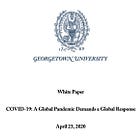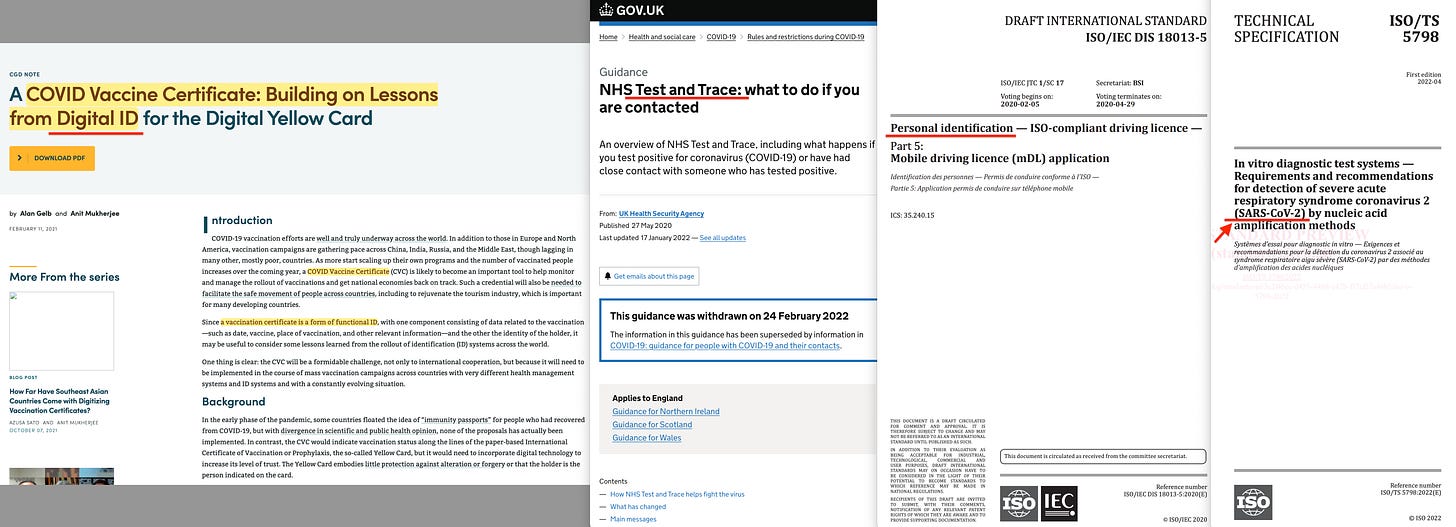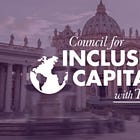COVID-19
Activation of a Pre-Engineered Global Governance Framework
The global response to COVID-19 was not a spontaneous reaction to a viral threat — it was the systematic deployment of a governance model gradually developed through the convergence of institutional protocols, technological infrastructures, compliance metrics, and codified ethical norms — all of which were activated in a coordinated fashion as soon as the alleged pandemic emerged.
And none of this was accidental, nor adaptive. It was premeditated, not least visible through the systems already active and ready for deployment by the break of the alleged disease.
Plenty of discussions are ongoing relating to the origin of the illness, the use of gain-of-function for the alleged sake of vaccine research, and whether viruses are real or not. I will declare up front that none of those will be discussed in this post. Rather, this will detail the largely unaddressed part of the story, relating to what happened in terms of systems activations already from early on in the alleged pandemic.
Two years ago I outlined my own scepticism relating to the break of Covid. Sure, when it did break back in 2020, I couldn’t quite tell you why everything was wrong, nor how it was all stitched together. But there were so many things which quite simply made no sense whatsoever — least of all, why people refused to discuss these matters rationally.
Yet precisely this stitching together is what’s covered precious little. I still see discussions relating to the topics mentioned above, but I hardly ever personally participate — because the more transformative development was the use of the pandemic as a systems-level trigger. COVID-19 did not merely constitute an alleged biomedical emergency; instead, it catalysed the activation of a strangely synchronous governance response in almost perfect unison, with virtually no democratic deliberation whatsoever.
Sure, Sweden’s measures were more liberal in their application1, while neighbouring Denmark in many ways was the poster-boy — though they, along with Norway, dared to challenge the AstraZeneca vaccination very early on indeed2. The UK, meanwhile, already early on applied aspects of the principles of subsidiarity3 to their response, locking down and quarantining local areas — while simultaneously arresting those who exposed empty hospital wards4, all while the in-the-know politicians partied5. And Australia weaponised its police force who went full paramilitary in its response6 — which made absolutely no sense whatsoever, given that the probability of catching the alleged illness on a beach was practically zero.
But the largely ignored aspects of the story relate to a response which — though these topics are covered individually — scaled beyond public health into finance, media, digital identity, and environmental domains in a breathtakingly fluent motion, as though this multi-sectoral activation was enabled at the flick of a switch — and this, even cross-country, by and large. An impressive feat, given that governments often struggle to agree on much in general.
At the commonly discussed Event 2017, held in October 2019, experts simulated a global coronavirus pandemic involving coordinated actions by health, media, and finance leaders. Subsequently, the real-world COVID-19 response reflected this playbook, with governments, corporations, and international bodies moving in lockstep — reinforcing the notion that the systems response was more pre-scripted than ad hoc. And other exercises, such as the 2017 SPARS Pandemic Scenario8, modelled a coronavirus outbreak, anticipating dilemmas in messaging, vaccine safety, reputational management, and the societal impact of rapid mandates — challenges that would become central during COVID-19. The 2019 Global Preparedness Monitoring Board report, A World at Risk9, even explicitly called for embedding pandemic response in national legal infrastructures, even stressed the importance of regular simulation, cross-border data exchange, and algorithmic readiness.
But it went beyond merely simulation. The 2009 H1N1 pandemic10 highlighted significant gaps in public trust and coordination, with critiques over panic-inducing communication and insufficiently cohesive governance, leading to calls for greater narrative control and integrated policy frameworks. Meanwhile, Collegium International’s 2009 Draft Charter for World Governance11 further argued that the 2008 financial crisis was a missed chance to reimagine global governance framed around ethics — precisely the type of anticipatory framework that laid the groundwork for the COVID-19 response.
What actually took place was that each precedent incrementally shifted public acceptance just a few inches, before the governance logic ultimately became operative in 2020, fusing advances in public health, technology, financial coordination, and ethical engineering in ways the public was barely even aware.
Perhaps the most significant transformation during the COVID-19 response was the shift from a traditional public health focus to a framework built on ethics by computation and cybernetic oversight. And that was not by coincidence, as this was the narrative they had progressively assembled since the emergence of the Manhattan Principles12 in 2004 (later to become the Berlin Principles in 2019), also known as One Health13 — a paradigm which declared zoonotic illnesses the result of disruptions to ecological balance, rendering it a necessity that the alleged virus had crossed over from a wild animal — with this particular one being claimed to be of bat origin (though this later changed, along with the rest of the ‘science’ on display).
But through the One Health framework, governments were called upon to conflate alleged illnesses with claimed environmental disruptions, as this would consequently demand synchronised management of human, animal, and ecological health. And, by amazing coincidence, major global institutions — including the WHO, FAO, UNEP, and the World Bank — had begun working in alliance to operationalise this holistic approach, integrating universal ethical logic and policy at unprecedented scale, almost immediately after the Manhattan Principles were delivered by William Foege at the Rockefeller Centre in 2004. A notable example of this is the 2006 WHO / World Bank pandemic response outline14, detailing quarantines, lockdowns, school closures, and so on — mirroring almost exactly what took place in 2020.
A further significant 2020 Georgetown University paper15, co-authored by Peter Piot — by his own statements, on his deathbed at the time of writing16 — outlined a technical framework resulting in a dystopian surveillance society which, the authors suggested, should remain post-pandemic. One, drawing on technologies such as AvesTerra17, facilitating real-time, computable surveillance across the human–environment interface — only months prior to a similar system being rolled out through the various track-and-trace programmes, using mobile phone tracking of people in what would appear to be a such gross violation of privacy that it beggared belief people willingly accepted it.
Legitimacy and ethical judgement were no longer static concepts grounded in precedent or tradition; instead, they became measurable, real-time outputs scored by algorithmic compliance, vaccination adoption, digital credentialing, and behavioural indices — all integrated into a ‘dashboard’ full of exciting statistics, thus subtly appealing to emotion and technological curiousity, while legitimate questions relating to the validity of the stats themselves were casually dismissed wholesale18.
‘Truth’ and ‘ethics’ were further operationalised19: compliance with policy directives became a proxy for truth, while adherence to protocol signalled virtue and moral acceptability. Those daring to question what was obviously at best inconclusive science were increasingly labelled, ridiculed, ostracised, and scapegoated — even by the very leaders elected to represent them.
And lockdowns — initially conceived as one of several possible containment measures — swiftly morphed into categorical ethical imperatives. Public messaging was continuously recalibrated to frame compliance not merely as respectful, but as a matter of collective moral responsibility. Non-adherence became associated not just with legal or civic failure, but with social deviance and, in many contexts, was stigmatised as ethically reprehensible20. Predictive models and scenario data served to validate this view by depicting non-compliance as both irrational and unethical, elevating the stakes of individual decision-making — all while questionable statistics, courtesy of the various health departments, served to confirm that those who refused the obviously questionable science were not only unethical, but outright unintelligent, as all stats allegedly proved that vaccines could in fact solve issues such as hospitalisation — an issue for which the vaccines hadn’t even been tested during those incredibly sketchy trials.
Yet the second the obviously gamed statistics started turning, these were suddenly rendered obsolete and would either be changed or entirely removed.
Meanwhile, governments worldwide deployed behavioural science at scale, employing nudge theory, emotional framing, and social norm recoding to strategically programme public compliance. In the UK, expert advisers even recommended Nazi-era fear-based communications to boost adherence, while elsewhere, ethical conformity was embedded into collective consciousness via well-crafted framing and peer modelling21. Population behaviour was measured, assessed, and shaped in an iterative cycle, aligning public instincts and social expectations with the directives of governance — a feedback loop which, at its core, was entirely cybernetic in nature.
Yet some people still had the nerve to speak of their personal experiences or dangerous observations, which then called for information controls and censorship, reframed as tools for ‘harm reduction’, with content critical of official narratives categorised as ‘misinformation’ and thus suppressed22, with dissenters further denied monetisation and visibility23. And when said dissenters later turned out to be correct, those who had aggressively called for outright censorship were the first to claim that ‘the science changed’ — with absolutely no display of humility in sight24.
And for healthcare professionals, strict adherence to public health mandates was expected, as dissent from institutional protocols was grounds not only for career repercussions but for accusations of compromised25 ethics26. The right to practice or teach became dependent on demonstrated compliance with the evolving codes issued by health authorities, eroding traditional medical and academic autonomy27.
A defining legacy of COVID-19 is the entrenchment of digital control systems as a permanent governance backbone. Originally justified as temporary emergency responses, these infrastructures increasingly regulate access to services, movement, and economic participation. Vaccination certificates were redressed as Digital ID systems28, which managed vaccine records and progressively extended to controlling entry to workplaces, travel, banking, and other vital services. Contact tracing29 was normalised, with some states deploying apps and data systems for pervasive real-time surveillance, while censorship designed for pandemic information30 management was progressively expanded to govern other domains, including environmental policy and political discourse.
These systems even function through interoperability standards, including ISO 1801331 for digital credentials, and pandemic-specific protocols such as ISO/TS 579832 for emergency data-sharing and support. Additionally, new digital twin33 standards and GEOSS34-derived surveillance platforms (ie GeoHealth35, EO4HEALTH36) merged satellite earth observation with health and behavioral data, creating unified models for planetary-scale monitoring and intervention.
Should you include mobile phone test-and-trace with those GEOSS-derivatives, you get a result of real-time live tracking of individuals, with even real-time satellite surveillance feeds — with the latter outlined in the 2019 Canberra Declaration.
And that Clare Sullivan — an early driver of Digital ID — would go on to work in the division of Georgetown where JC Smart (the author of the protocol enabling real-time surveillance per the 2020 paper discussed above) was based, should amply highlight exactly where this is all going.
But a world in which each and every one of us is meant to live under continuous personal tracking — while a 24/7 network of spy satellites transmits real-time satellite feeds — is only one side of the cybernetic coin. The other relates to the statistics we were continuously fed37 — case counts38, hospitalisations, and deaths39 — because as those figures changed, the appropriate response was crafted40: first through displays of virtue and behavioural nudges, then through policy adjustments and sanctions, and later through the adjustment of permissions, with quarantines soon to follow. This continuous, cybernetic cycle would endlessly chase the alleged illness… all while people were prosecuted for recording video clips at empty hospitals.
In other words — the alleged indicators of illness which were not to be challenged, were weaponised against the people, and expressly used to set policy regardless of democratic will. And when the people eventually rebelled, the police were consciously sent to crack skulls — visibly throughout the Netherlands, France, Australia, and later Canada — where those daring to protest the obvious quack science had their access to bank accounts cut41, demonstrating exactly how much power is vested in financial institutions, but also why they now seek to eliminate cash outright.
And in each case, the mainstream media was busily defending increasing authoritarian controls through claims of ‘saving lives’, while framing dissenters as societal violators of the ‘common ethic’ — an ethic no one was ever given the chance to discuss, nor vote on, and which was entirely dictated by opaque models no one could realistically challenge, on basis of fraudulent ‘indicators’.
Governance during the pandemic relied not primarily on coercion, but on emotional engagement — casting compliance as compassion42 and solidarity43. Mandates were thus presented as ethical expressions of care for one’s community, while resistance was depicted not only as risk-taking but as a moral failing, with dissenters censored in the name of the dashboard-driven computational44 common good45, ostracised, and denied access to their bank accounts in the name of ‘protecting lives’ should they dare rise up — all while a backlog of cancer cases predictably grew46.
This rhetorical strategy ultimately sought to reduce public resistance and harness empathy, ensuring the voluntary internalisation of step-by-step changes, which were always promised to be temporary47. And when these lies eventually crumbled, the solution was outright censorship48 and the open use of force49 — precisely in the way authoritarian regimes regularly operate. Yet the same mainstream media which routinely cover riots in nations considered ideologically hostile militantly refused to cover the widespread dissatisfaction with the undemocratic trajectory, not merely in their own, but also in friendly nations — well, except for the occasional hit piece targeting those who could not easily be dismissed as ‘conspiracy theorists’50.
The point here is this:
The PCR tests were unreliable, often detecting non-infectious viral fragments and generating false positives, especially when cycle thresholds were set excessively high.
People were not considered ‘vaccinated’ until two weeks after injection, resulting in a statistical conflation where post-vaccine infections and adverse events were attributed to the unvaccinated — effectively redistributing the information signal and muddying meaningful interpretation.
Deaths were routinely recorded as ‘Covid-related’, even when COVID-19 was not the actual cause, distorting mortality data.
Claims of overwhelmed hospitals were exaggerated or outright fabricated, with footage of empty wards dismissed or censored.
The few public officials who refused to accept the obviously flawed narrative were not only mocked or deplatformed but often investigated, fired or even prosecuted — as public discourse narrowed to only what aligned with institutional messaging.
And it all boils down to this:
The statistics produced during this period of time constituted the worst kind of quack science imagineable — a blatant and egregious case of intentional statistical fraud, deployed to drive a political narrative with no grounding in reality whatsoever.
And these fraudulent statistics, in turn, drove the political response — first through soft coercion techniques like behavioural nudges, then through penalties for non-compliance, followed by lockdowns and quarantines. All of it was justified in the name of the common good, underpinned by statistical fraud that the leading scientists in most nations absolutely should have known was not grounded in evidence.
And as the fraudulent numbers allegedly changed, so did the political response — without this ever being subject to credible democratic debate. It was a response driven entirely by adaptive management, fuelled by indicators based on manipulated data. And this, in short, marked the unofficial launch of the future of global governance — where indicators, derived from surveillance data, are processed by opaque models, and used to cybernetically trigger political responses.
And as to whether the statistics were fraudulent... well, it kind of doesn’t matter. Because should you disagree, Australia showed precisely how those politicians serve the public — by unleashing a police force akin to brownshirts, cracking the skulls of those who were not to be heard. And if the protests became too large to be controlled in this fashion, then Trudeau in Canada demonstrated the next step: cutting off access to your bank account — while simultaneously praising those who protest ‘for the right reasons’.
The architecture underpinning these transformations was anticipated well before COVID-19. UNESCO’s 1968 Biosphere Conference51 recommended anticipatory, interdisciplinary management of the biosphere, linking zoonotic risk with environmental imbalance and advocating for global cooperation and early warning systems. The modern One Health Data Commons52 realises this vision by integrating environmental, biological, and behavioural data into a system designed for continuous, computable moral surveillance on a planetary scale53. Through such platforms, actions preserving or violating planetary integrity are algorithmically defined and monitored54.
And how do these systems operate? Simple: through indicators — which, in reality, are little more than normalised surveillance data of precisely the sort that enabled gross abuses with impunity during the alleged pandemic.
And why is that a problem?
Because the next alleged pandemic will be ‘predicted’ through the use of Digital Twins and Artificial Intelligence, and declared by the World Health Organisation — without you having any option to object.
And all of the data input for this purpose will be of exactly the same quality as that used during the alleged 2020 pandemic.
And should you manage to overcome (1) the algorithmic censorship on social media, (2) the tedious ‘fact checks’ and one-sided claims of ‘missing context’, (3) the weaponised labels of ‘misinformation’ and ‘disinformation’, (4) the demonetisation, (5) deplatforming, (6) the loss of your job for supposed ‘ethics violations’, (7) the ostracisation, (8) the relentless behavioural manipulation disguised as ‘nudging’ — including lies like ‘just two more weeks’, (9) the quarantines, (10) the activation of Australian brownshirts, and (11) the grossly abusive attempts to cut off access to your own money — then you will eventually arrive at (12) the corrupt scientists who knowingly produced outright lies about the supposed damage to public health.
And yet, they will still claim their science was conducted ‘in good faith’, insisting that the problem lay with the ‘indicators’ — which, conveniently, were crafted by yet more scientists, who will then again shift the blame with complete and utter impunity.
In other words — absolutely no one will be held accountable.
And as future ‘pandemics’ are modelled through simulations you cannot challenge, using ‘indicators’ that are almost certainly fraudulent, the scope of control will only expand. With the inclusion of ecosystem health via the One Health framework in the recent Pandemic Treaty, it now quite literally means you could be locked down because a migrating hyena catches a cold.
And you will not be able to object — because no one is responsible.
The politicians? Sure, they followed through. But had they refused, the same people who funded those scientists and corrupted the ‘indicators’ would have unleashed the combined force of the lying mainstream media organisations, the fraudulent ‘fact-checker’ networks, the corrupt social media platforms, and their crooked AI algorithms — all steered under the guise of ‘AI ethics’ — to ensure they’d be out of office in a heartbeat.
In other words — during a future alleged health crisis, global surveillance data yielding gamed indicators will be fed into corrupt models, producing predictions of 250 trillion deaths, all because a bat died prematurely in Mongolia — and no one will be held responsible. Least of all when you're locked down and forced to accept a Digital ID, because it will be the only way to access your bank account, your online grocery orders, and your healthcare — lest you be labelled ‘unethical’.
And that, in turn, will open the door to Central Bank Digital Currencies, eventually followed by 15-minute cities and a mandatory vaccination schedule — all, of course, to protect you. Anything else would be ‘unethical’.
And that takes us right back to early 2020. Because the operation and expansion of this new governance model were only possible with the express backing of central banks and national monetary authorities. Extraordinary liquidity injections, support for sovereign debt, and comprehensive financial stabilisation packages underwrote the continuity of digital surveillance, behavioural management, and social control mechanisms. This ensured that the ethical authority of governance was matched by the practical capacity to enforce and sustain it.
Because without the express backing of what was clearly a BIS-coordinated COVID response, most nations simply would not have been able to afford the outrageous price tag that came with trampling wholesale on democratic rights55 — all while lying to the public about a fabricated dangerous illness, somehow connection to bats.
And the shamelessness of it all was precisely outlined only 3 days ago, as the very same Bank for International Settlements who most certainly colluded, enabling this vast increase of public sector debt, now call on the governments to shrink their debt piles56.
Well, frankly, that alone should call for all internal central bank communications relating to the obviously corrupt event — Covid — to be made public.
The COVID-19 pandemic did not dismantle existing governance — it revealed, activated, and upgraded it. The post-pandemic world now operates under an integrated, dynamic, and computational architecture in which behavioural science, digital identity, algorithmic feedback, and financial coordination are inseparable components of a global moral operating system — ultimately controlled through corrupt computational models and fraudulent indicators derived from creeping, global surveillance.
This system is actively evolving, and the precedent has been set: compliance, legitimacy, and morality can now be engineered, monitored, and encoded. The infrastructure stands ready for future triggers, having transformed what was once emergency management into the core logic of global governance. A trajectory further supported through the final Pandemic Treaty57, which appears to relate not so much to the exception, but rather the creation of technocratic institutions and mechanisms — exactly as we’ve continuously witnessed since the IIASA was established in 1972.
And when… yes, when the next crisis emerges — with the One Health approach now framing any form of ‘ecocide’58 as a threat to human health — the next steps toward sealing the authoritarian control grid will be taken.
And the central banks will, yet again, be more than accomodative in their response. After all, the end objective is a ‘moral economy’, isn’t it?

























